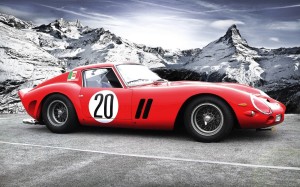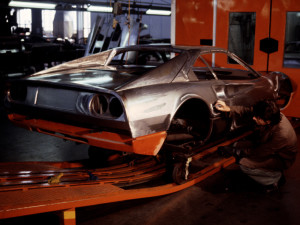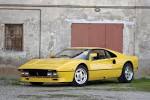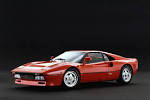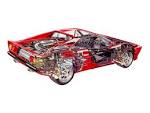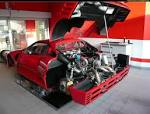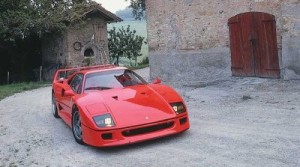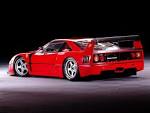Hunting with the Ferrari F40

In 1987, the Ferrari F40 was born to celebrate the fortieth anniversary of Ferrari. The F40 design was intended to take a specific prey in, but I will come back to that later.
Actually, as early as 1962, the Ferrari 250 GTO laid the foundation of the F40 (see article: ‘the Ferrari 250 GTO: of unprecedented beauty’). From there the following models eventually resulted in the F40:
- 308/328 GTB/S
- 288 GTO
- 288 GTO Evoluzione
Pic.: Ferrari 250 GTO
In 1975, the Ferrari 308 GTB was introduced at the Paris and London car fairs. The car was designed by Pininfarina and built by Scaglietti. The engine was equal to the one used in the 308 GT/4, but the GTB had dry sump lubrication providing better cooling and a lower engine position. The frame design had copied a number of striking features of the Dino 246 GT, such as air inlets in the door, round 2-lamp rear lights and vertically concave rear windows which made it a very successful successor of the Dino.
A not directly visible, but striking feature of the 308 GTB was the entire frame, except the aluminium front valve, being made of fibre glass. For Ferrari this was the first production car containing a frame made of this material, but at the same time the last one. Ferrari did not use fibre glass any more for a car manufactured in large amounts; after that however, loose parts like the front and rear wings or the nose of the car, were often made of fibre glass. From the autumn of 1976, the cars for the American market were manufactured with frames made of the more familiar pressed steel and aluminium, and from the mid 1977s the same was true for the European models.
Pic.: Ferrari 308 GTB/S
The models for the European market had tube frames with serial number F 106 AB 100. The 308 was provided with disc brakes and an independent wheel suspension with wishbones, springs and hydraulic shock absorbers surrounded by anti roll bars.
The transversely positioned aluminium V8 mid-engine had the 90-degree configuration and a content of 2926 cc, with a bore and stroke of 81 mm x 71 mm (serial number F 106 AB 000 for the European market). The 308 had an ‘all synchromesh’ five-speed gearbox positioned below the engine and against the back side of the dry sump (the European models exclusively). The cars for the European market had 255 HP, the USA models 240 (this in connection with emission regulations). All of the manufactured cars were provided with odd frame numbers. The production ran from 1975 till 1980 and during those years 2897 308 GTB/S were produced with the frame numbers 18677 to 34349.
Pic.: Ferrari 288 GTO
Ferrari developed the 288 GTO in order to take part in the new group of B Race series for which at least 200 samples were needed for homologation. However, after the death of Henri Toivonen and his co-pilot Sergio Cresto in the 1986 Tour de Corse the FIA did away with this racing class due to which only the Group A Rally championship remained. Eventually, the 272 280 GTOs built between 1984-1985 did not race, but remained road cars.
By the way, Ferrari initially built 270 GTOs, but then they intended to present Niki Lauda (see article:’Niki Lauda: passionate race-driver) with a 288 to thank him for his efforts as a Formula I race-driver for Ferrari in the 70s (world champion in ’75 and ’77). Number 272 was built out of spare parts for an American car-lover.
Ferrari built the following 6 prototypes of the 288 GTO for various purposes:
- 44725 GT’SWB’: standard testing
- 44421 GT’LWB’: standard testing, crash test
- 44727 GT: brake and frame testing
- 47647 GT: test car for electronic system and turbochargers
- 47649 GT: road and endurance testing
- 47711 GT: speed limit and acceleration testing
The first two prototypes had 2.88-litres V8s with KKK and IHI turbochargers respectively, the other four had GTO engines.
Later another prototype was built to be used for the development of the 288 GTO Evoluzione:
- 50253 GT: 650 hp Evoluzione engine, test car for the F40
When taking a first quick glance at the styling of the 288 GTO, it seemed a logical evolution of the two previous Pininfarina designs, the Berlinetta Boxer and the 308. However, it turned out to be a completely new car of which even the dimensions deviated from the previous models. The 288 was shorter, had a longer wheel base and was significantly broader, all features of a racing car. The air inlets and outlets were focused on racing as well. Furthermore, the high-positioned wing mirrors and the striking Kamm tail (invented by the German Professor Wunibald Kamm [1893-1966]; already applied to the 250 GTO) could be noticed leading to higher speed and more stability. Chromium could hardly be found on the 288 and even the Cavallino Rampante at the back side was black. The 288 GTO was delivered in one colour only: Rosso Corsa.
The 288 frame consisted of fibre glass and composites. The bottom and most of the frame parts were made of pressed fibre glass, and aluminium, Kevlar and Nomex were also used for other specific parts. The tube frame consisted of several subframes attached to the central part around the cabin. The entire back subframe, with wheel drive and back wheel suspension, could be removed from the car in one part for faster maintenance (also typical of a competition car).
The 288 GTO was driven by a longitudinally positioned 2.855 cc 90-degree V8 Twin Turbo light metal engine. The engine block was behind the passenger’s cabin and connected with the back transaxle. Every cylinder row had its own ignitor, its own large IHI Turbo with Behr Intercooler and was fuelled by its own aluminium fuel tank (two tanks, inter-connected, with a total content of 120 litres). The 288 was provided with an entirely synchronised five-speed gearbox with hydraulic single-plate coupling.
Although designed for racing the 288 GTO interior was far from spartan. The majority of the clients opted for kevlar, black-leather bucket seats, an option was black with orange hems. The dashboard was provided with non-reflective material and behind the three-spoke steering wheel were black/orange indicators. The car had climate control and sound reproducing equipment.
Pic.: Ferrari 288 GTO
The 288 GTO was a fabulous car, but one thing kept bothering Ferrari. In the country of castles, frying sausages and beer festivals a car was manufactured that drove even faster than the 288GTO: the Porsche 959. This was the prey the F40 still to be developed had to hunt for.
Ferrari developed a competition version of the 288 GTO, the 288 GTO Evoluzione, its sole purpose being to serve as a testing car for the F40 (Ferrari no longer participated in competition, Group B in the World Rally Championship). Giovanni Razelli, Ferrari’s general manager, called the Evoluzione a ‘mobile laboratory’.
In mid-1983 Nicola Materazzi’s first priority was the engine.
The F 114 B of the standard GTO had to be converted into the F 114 C. By relatively simple interventions, including increasing turbo pressure, its capacity was driven up from 400 to 600 hp. The total weight was reduced to 1,000 kg (including full tanks) and extensively aerodynamic testing was done. Eventually, Ferrari built 3 samples of the 288 GTO Evoluzione, chassis numbers 50253 GT, 70167 GT and 70205 GT, which are still being used for testing.
Pic.: Ferrari 288 GTO Evoluzione
On 21 July 1987, at Ferrari’s 40th anniversary, the Ferrari F40 was presented. At 11.09 h sharp, a Lancia Thema limousine driven by Enzo Ferrari was driven up to the entrance of the ‘centro civico’ in Maranello. The unpretending hall of the ‘centro civico’ was crowded with journalists from USA, Japan, Brasil, England, France, the Arabic States and Italy.
The F40 was Ferrari’s answer to the Porsche 959, a delicate item in Maranello. Materazzi had watched the 959 project with interest, but he was also sceptical about it, stating:”As an engineer, I found the things they were doing in Weissach fascinating. But I don’t hold with the idea of packing so much technology into a fast road car. What tends to happen is that technology becomes an end in itself, which has a demotivating effect on the development team”.
Dr. Leonardo Fioravanti, Pininfarina’s general manager, who was responsible for the F40 design, elucidated his opinion about the car:
“With its central passenger cell, flat front section, favorable aerodynamic properties and sealed underbody, the F40 is a quintessential sports car. One of its outstanding features is the low, flat nose, which harks back to the classic Ferraris of the 1960s, with their exceptionally clean and functional lines. It has a central air intake for the oil-cooler and the optional air-conditioning system, and two further air-holes, mounted on each side, for the ventilation of the disc brakes. The two small NACA vents in the hood supply fresh air to the interior. In addition, on each side of the car there are two air intakes for the rear disc brakes and the air supply to the engine, plus air escape vents on each of the front fenders. The rear section also has a markedly sporty appearance, which is emphasized by the large rear wing. The rear window, which extends across the width of the car, has a semi-conical form and directs the air-flow onto the wing, thereby maximizing its aerodynamic effect.”
About the interior Fioravanti said:
“When we began to design the interior, our main concern was that it should be as functional as possible, in order to make it fit in with the general character of the car. For this reason we decided to equip the car with sliding windows and racing car pedals. The dashboard, which is made from a special compound material, also derives directly from racing car design and is hence in keeping with the overall concept of the F40 as a sports car.”
Pic.: Ferrari F40
During the developmental process of the F40 the following interesting step took place. The frame of the car had to be distinctly stiff, but also light. In order to test this frame Sergio Scaletti designed a four-seat cabriolet with a Ferrari 412 engine. Scaletti stated:”The reason for choosing this particular format was that we wanted to compare the car with the 2+2 coupe. We were extremely pleased with the result: the new vehicle was several hundred kilograms lighter than its predecessor, and its stiffness was improved by a factor of four of five. Incidentally, the frame of this experimental car was made in one piece, as in racing car technology.”
Pic.: Ferrari 412 convertible from 1984
Nicola Materazzi said about the engine:”With 55 mkg of torque at 3.500 rpm, we have achieved our original objective. At 7.000 rpm the car delivers 478 bhp, which is enough for anyone except Enzo Ferrari, who initially hoped that the LM would reach 500 bhp.”
The F40 (also called LM) accelerated from 0-200 km/h in 12 seconds and its top speed was 324 km/h (201 mph). By making the frame parts out of composites the F40 weighed 100 kg less than the 288 GTO which was indeed a lightweight car.
The F40 was nothing less than a racing car with a number plate. The hunt for the Porsche 959 could be opened.
Jaap Bakker
Leave a Reply



